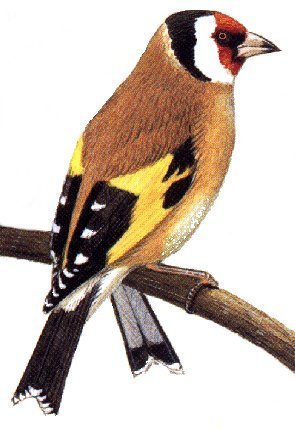
This is the time of year throughout North America when birders take their annual “Christmas counts.”
This involves identifying and counting what bird species birders and casual observers have seen in their area.
Besides the various extremely large avian cryptids that avoid detention by having small numbers, being ignored, flying too high, hiding, and remaining in remote locations, mystery birds do turn up.
You have to read Christmas counts closely to find them, but they are there. Most are eventually seen as identified species that have turned up in out-of-place sites.
For example, on December 29, 2007, Mike Jacobs of the Grand Forks Herald writes an interesting column on a mystery bird seen at Strandquist, Minnesota.
Jacobs’ creature is detailed in this partial selection from his thoughtful article:
The stranger that showed up at Shirley Anderson’s bird feeder was a European goldfinch. There’s no doubt of that. Anderson gave a detailed description, and she followed that up with photographs.
So, that mystery is solved.
The deeper mystery is how did a European goldfinch get to Anderson’s feeders in Strandquist, Minn.?
The word “European” is descriptive here. This is an Old World bird.
It’s true that the European goldfinch has a place in New World bird books, usually on the last page and often under a dismissive label.
In “The Sibley Guide to Birds,” David Allen Sibley has this to say about the European goldfinch:
“Many attempts at introduction around North America have failed; occasionally escapes from captivity.”
This treatment occurs on page 537, which appears just ahead of the index and is labeled, “Exotic finches.”
So, how did a European goldfinch make its way to northwestern Minnesota? There are three possibilities.
One is that this bird is a local escape. European goldfinches are kept as cage birds, and it’s possible that someone in northwestern Minnesota lost one.
A second possibility is that this bird is one of a release in the Chicago area in 2002. A number of caged birds were released, and this resulted in nesting records for chaffinches and widespread sightings of European goldfinches. Goldfinches were reported from Whitefish Bay in Michigan and Gimli in Manitoba.
It may be significant that both of these places are on large bodies of water, which might have stopped the flight of the goldfinches.
Of course, that wouldn’t explain why a European goldfinch showed up in Strandquist.
This release occurred more than five years ago, about the limit of a goldfinch’s natural life – especially in the center of North America, where the weather is much colder than it is in continental Europe.
This raises the intriguing possibility that Shirley Anderson’s bird is the offspring of birds that fled the Chicago area. Of course, this supposes that the birds nested successfully somewhere in the Upper Midwest.
Of course, we can’t know for sure.
One certainty: The bird indeed was a European goldfinch. by Mike Jacobs, “Strandquist hosts a bird of mystery,” Grand Forks Herald, December 29, 2007.
Image at top: European Goldfinch by H. James.
Follow CryptoZooNews
Not Found
The resource could not be found.